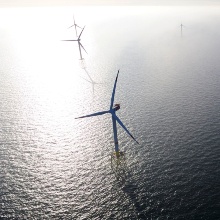What is the best way of predicting the power output of a wind farm in the minute-scale, and how big is the uncertainty of the prediction in the event of major changes in wind speed? Researchers at the Stuttgart Wind Energy (SWE) Chair at the University of Stuttgart and the Centre for Solar Energy and Hydrogen Research Baden-Württemberg (ZSW) hope to clarify these questions as part of the ParkCast research project funded by the Federal Ministry of Economics and Energy with around 1.14 million euros.
The share of renewable energies and wind power in particular is rising steadily. In order to ensure a stable grid for the consumer, accurate forecasts of the power input into the energy grid are absolutely necessary. In spite of the constant fluctuation in the output of wind turbines - the wind does not always blow the same way - it must therefore be ensured that the generation and consumption of electricity are always balanced. With the help of precise forecasts of the power generated by a wind farm in the near future, it is possible for the grid operator to better plan how the energy mix is to come about and whether, for example, a gas power plant has to be started up right away in the event of an incoming wind calm in order to compensate for the loss of power.
For this purpose, the Stuttgart researchers have started a pilot project at the offshore research wind farm alpha ventus off the North Sea coast of Lower Saxony in the German Bight. The aim is to predict the output of the twelve wind turbines there as accurately as possible in a time range of up to 60 minutes. A lidar device is used for this purpose. This laser measuring instrument, which will be installed on the nacelle of one of the 5MW turbines, can measure wind speed up to ten kilometres away. The lidar device will measure the inflow into the park and provide this information as a basis for the forecast. With the help of a local, numerical weather model, which depicts the state of the atmosphere at the site, the flow of the wind towards the wind farm can be calculated and forecast by entering or assimilating the measured wind speed values from a distance of a few kilometres. With the help of a wind farm performance model, i.e. the knowledge at which wind speed the wind farm generates how much power, the future power output can then be calculated. Current methods of machine learning are also used for this purpose.
The Stuttgart Chair of Wind Energy and the Centre for Solar Energy and Hydrogen Research Baden-Württemberg (ZSW) are project partners of the WindForS research network, which bundles research and teaching on wind energy in southern Germany. The Chair of Wind Energy was founded in 2004 and since then has concentrated its research on the system understanding of wind turbines. With the project ParkCast, the measuring technology team of the chair ties in with the predecessor project VORKAST, in which minute-scale forecasts of the wind power of an individual wind turbine were examined by means of lidar measurement. With this project, the University of Stuttgart is a partner in the RAVE initiative (Research at Alpha Ventus).
The Center for Solar Energy and Hydrogen Research (ZSW) was founded in 1988 as a non-profit foundation and is today one of the leading institutes for applied research in the fields of photovoltaics, regenerative fuels, battery technology and fuel cells as well as energy system analysis. The three ZSW locations in Stuttgart, Ulm and Widderstall currently employ around 250 scientists, engineers and technicians. The ZSW sees itself as a bridge between basic research and industry: Together with industrial partners, it brings the technologies to the market. The company's technical expertise is also incorporated into studies and consulting services for politicians.
Expert Contact:
Ines Würth, Lehrstuhl für Windenergie, 0711/685 68285, Mail


